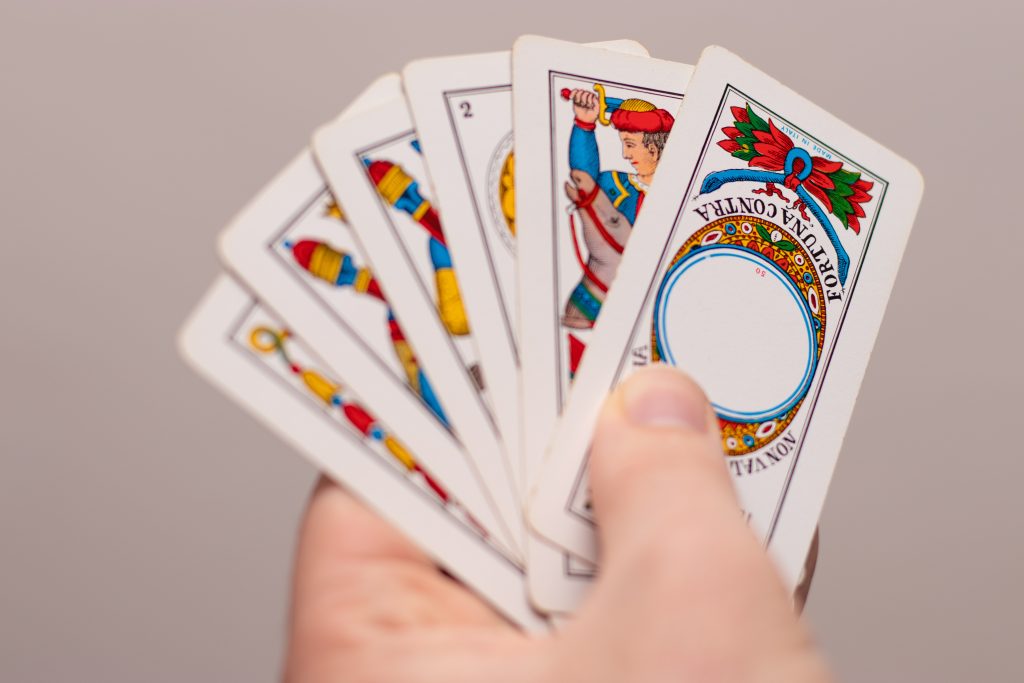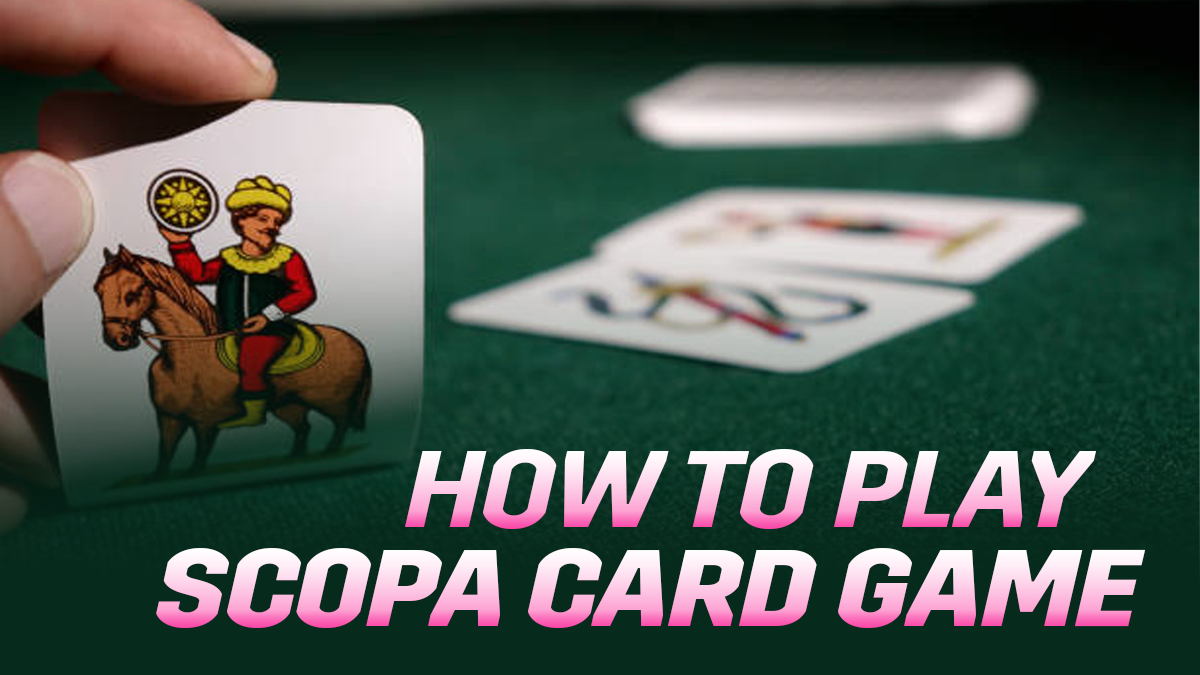Table of Contents
ToggleScopa is well-known among traditional Italian card games. It belongs to the Fishing-type genre, just like the Spanish Escoba and the Tunisian Chkobba. The name Scopa means “broom” in Italian. It reflects the core gameplay, where players “sweep” cards off the table by capturing them with smart plays.
The Italian card game Scopa is deeply rooted in Italian culture and is a favorite pastime for families and friends. It involves a custom 40-card Italian deck. The game is a blend of strategy, memory recall, and skill.
For beginners, scopa card game rules are easy to grasp. Assimilating them and displaying a spontaneous strategy takes practice. So, here we’re to discuss the basic game rules, gameplay, winning strategy, and more. Let’s start with the basic rules for Scopa card game before we learn how to play Scopa!
Scopa Card Game Rules

Source: Antonio Batinic /shuttertock
- Imagine that a played card matches with both a single card and the sum of a set of cards on the table. You can only capture a single card, not a set of cards.
- As per the Scopa card game rules, you’re free to play any card from your hand. You can go without performing a capture on your turn, even if you have the possibility. You can use this flexibility in your strategy to finish the game quickly.
- If a played card can capture, the player must capture. They cannot leave the card on the table, even if it might benefit their strategy.
- Taking the last cards on the final turn does not count as a scopa. For example, if the table has a 3 and a 5, and you play an 8 to capture them, it won’t earn a scopa if it’s the final turn.
Read More: How to Play Pai Gow Poker Game, Rules, Scoring, & Strategies!
How to Play Scopa Card game
Objective
The objective of Scopa is to score points by capturing all the cards from the table and reach the target score first. The target score is usually 11 points.
Players aim to achieve specific goals. They can collect the most cards, coins/diamonds, or high-value cards for the Primiera.
Game Setup
Compared to the card games with standard 52-deck, setup is slightly different for Scopa game.
- Deck of Cards: A 40-card Italian deck or a standard deck with 8s, 9s, 10s, and Jokers removed. Each suit contains ten cards.
- Score Tracker: Pen and paper or tokens to track points.
- Playing Surface: A flat table or surface.
- Number of Players: Two is the common practice. But you can adopt the game for three or four players, or six players. Even number of players are the norm. The gameplay proceeds anti-clockwise for more than two players.
Card Ranking
The card ranks for the purpose of capture are as follows:
- King is 10.
- Horse or Queen is 9.
- Jack is 8.
- 7, 6, 5, 4, 3, 2 carry the face value.
- Ace is worth 1 point.
You can also use 52-deck Fench-suited cards to play the game, especially if Italian cards are not available. However, 10s, 9s, and 8s must be removed.
Dealing
A dealer is chosen through any flexible method. The dealer shuffles while the dealer’s opponent (or player to the left of the dealer if there are 2+ players) cuts the cards.
The dealer deals three cards to each player. Four cards are dealt to the table in face-up position, either in square layout or a row. The remaining cards are placed face down.
If there are three or four Kings in the four face-up cards, cards are shuffled again. They are cut, and the same dealer deals. When there are more than two face-up Kings in the layout, forming sweeps (scope) is not possible.
How to Play Scopa Card Game with Two Players
After the dealer deals the cards, the first player plays one of his cards. The second player also plays one card. The gameplay continues.
After each plays three cards, they receive three more cards from the stock. Once again, this continues until no cards are left in the stock.
On their turn, the player plays one of their cards. Here, there are three scenarios:
Scenario 1
If the card played is equal to one of the cards on the table in value, he/she can capture both the played card and the table card with the same rank.
For example, if 2, 5, and 8 cards are on the table, the player plays a card with the value 8. Now, the player can capture both the played 8 and table’s 8, and add them to their capture pile.
Scenario 2
If the card played is equal to the sum of two or more cards on the table, the player can capture all those cards along with their played card. Three situations are possible here:
- Capturing multiple cards
The player plays a 7, and the table has 3, 2, and 4 cards.- The player captures the 7 (played card) and the 3 and 4 (since 3 + 4 = 7).
- Choosing between multiple combinations
The player plays a 6, and the table has 4, 2, and 3 cards.- The player can capture the 4 + 2 or the 3 + 3. They can pick only one of the combinations and take those cards.
- Capturing a single card (precedence rule)
The player plays a 10, and the table has 10, 8, and 2 cards.Although 8 + 2 = 10, the player must capture the single 10 card from the table because capturing a single card takes precedence over combinations.
Scenario 3
If you find no matching cards on the table, you have to discard your played card to the table in the face-up position. It joins the table pile with the rest of the cards. It is impossible to discard a card that matches table cards in one of the above two scenarios.
Now, imagine your played card captures all the face-up cards from the table! You have a scopa (aka Sweep) on your hands. If you have played the last card and find that there are still cards on the table, they will be captured by the one who captured the last time.
Scoring Rules
Scores are tallied after all cards on the table have been played. It is based on the cards in the capture piles and for sweeps.
| Category | Condition | Points |
| Scopa (Sweep) | Each scopa (sweep) in the capture pile. | 1 per scopa |
| Most Cards | Most cards in the capture pile (no tie points). | 1 |
| Most Coins | Most cards in the coins/diamonds suit (no tie points). | 1 |
| Settebello | Holding the 7 of coins/diamonds. | 1 |
| Primiera* | Best prime (one card of each suit, highest total value). No score if a suit is missing. | 1 |
While each scopa carries one point, there are four additional points to achieve.
*To find out the best prime, the prime value of the highest-value card from each suit is added.
| Card Value | Prime Value |
| Seven | 21 points |
| Six | 18 points |
| Ace | 16 points |
| Five | 15 points |
| Four | 14 points |
| Three | 13 points |
| Two | 12 points |
| All other cards | 10 points |
If a player doesn’t have any card of a certain suit, its prime value is 0.
Example Calculation
Player’s captured cards:
- 7 of Coins (21 points)
- 5 of Hearts (15 points)
- 6 of Spades (18 points)
- Ace of Diamonds (16 points)
Prime total: 21 + 15 + 18 + 16 = 70
Scoring for the round:
- Settebello: 1 (one point) (7 of Coins)
- Primiera: 1 (one point) (Prime score: 70)
- Scopa: 2 (two points) (2 sweeps achieved)
- Most Cards: 1 (one point) (player captured the most cards)
- Most Coins: 1 (one point) (player captured the most cards in the Coins suit)
Total Score for the Round: 1 (Settebello) + 1 (Primiera) + 2 (Scopa) + 1 (Most Cards) + 1 (Most Coins) = 6 points
Cumulative Points:
- If the player had 5 points from previous rounds, their new total becomes 11 points. They win the game.
If both players reach 11 points at the same time, they have to play another round to determine the winner.
How to Win Scopa Game: Strategies and Tips

Source: Simun Galic /shutterstock
- Track Played Cards: Pay attention to which cards have been played to predict your opponent’s moves. It reveals whether you can hold or play a card strategically.
- Balance Scopas with Overall Strategy: Chasing Scopas can be tempting. But focus on capturing valuable cards to maximize points. For example, Sevens or Coins.
- Avoid Risky Plays: Don’t leave high-value cards on the table. Your opponent could easily capture them. Play cards that reduce their chances of making big moves.
- Smart Captures: When choosing between capturing with one card or multiple cards, go for multiple cards. You will leave fewer options for your opponent, limiting their chances of a strategic play.
- Use Lone Cards to Your Advantage: Sometimes, leaving a single card can force your opponent to capture it. You will have a better move in the next turn.
- Control the Coins: Capturing Coins (or Diamonds) fetches score points. Always prioritize capturing these cards when possible.
- Plan for the Prime: To win the Primiera, aim for a balanced collection of high-value cards in different suits. Aces, Sevens, and Sixes are particularly valuable for this.
- Block Opponent’s Scopas: If you anticipate your opponent is close to making a Scopa, play cards to disrupt their setup. Preventing their Scopa can be as important as making your own.
- Think Ahead: Look at the table and imagine what your opponent might do with your card. Avoid plays that could lead to them capturing multiple cards or setting up a Scopa.Scopa Game Rule Variations
There are plenty of Scopa variants across the world. They differ in rules for scopa card game scoring rules, type of card deck, target score, etc.
1. Score Variations
The target score of 11 is not a hard rule. You may use a different target score if all the players agree, e.g. 16 or 21. In some variants where extra points are possible, it is increased to 31 or 41.
Yet in some Scopa variants, a player or team can end the game early by declaring they have enough points to win, called “chiamarsi fuori.” To claim this:
- Cards Point: The player must have 21 cards.
- Coins/Diamonds Point: The player must have 6 cards of that suit.
- Prime Point: The player must prove they will win the prime, even if the opponent claims all remaining cards.
If their claim is false, they lose the game automatically.
2. Primiera
In some parts of the world, different scales of values are used to play Scopa. For example, 2-7 can be face values, Aces 5½ and picture cards ½. In the end, these values yield the same result as normal values.
3. Scopa di Quindici
In some Scopa versions, players capture cards that sum to 15 with the played card. For example, if the table has A, 3, 4, 7 and you play a 4, you can capture either 4 + 7 or A + 3 + 7, based on your choice.
- First Version:
Players capture cards that, together with the played card, total 15. Cards equal to the played card cannot be captured. This version closely resembles the Spanish game Escoba. - Second Version:
Players can capture:- A single card equal to the played card, or
- A set of cards totaling 15.
When there are multiple options, players must capture the fewest cards possible.
- Third Version:
Similar to the second version but adds:- Ace Rule: An Ace captures all cards on the table, earning a Scopa point.
- No restriction on which cards to take when multiple options exist.
This version is typically played to 31 points.
4. Other Prominent Versions
| Variant | Scopa Rules | Common Target Score |
| Asso Pigliatutto | Playing an Ace captures all table cards and scores 1 point for a sweep.If an Ace is already on the table, only the Ace is captured. | 11-31 |
| Scopa d’Assi | Similar to Asso Pigliatutto, but capturing all cards with an Ace does not count as a sweep.Often played with additional points for a Napola. | 21-41 |
| Re Bello | Awards 1 extra point for capturing the King of Coins/Diamonds. | Flexible |
| Napola | Points awarded for sequences of Coins/Diamonds starting from Ace (e.g., A-2-3 = 3 points).Longer sequences score more points, up to 10 for a full suit (Napoleone). | 21, 31, or 41 |
| Scopa Corse | Played with a 36-card deck (Twos removed).Capturing is optional.Played with two or four players in partnerships. | 21 |
The Origins of the Scopa Card Game
If you’re a beginner to the Scopa game, you might wonder where this 40-card deck came from: “After all, I am used to 52-deck card games.” Well, there’s a history.
Scopa dates back to at least the 15th century in Italy. It emerged as a popular pastime among all social classes. The 40-card deck, featuring four suits—Coins, Cups, Swords, and Clubs—was derived from traditional Italian tarot decks. They were streamlined for simpler gameplay.
Unlike the globally popular 52-card French-suited cards, Italian regional decks reflect cultural artistry and historical influences. Over time, Scopa spread beyond Italy, giving rise to similar games like Escoba in Spain and Chkobba in Tunisia. For card game lovers, the game has also become a favorite, allowing them to play with strategy and wit.
In the End…
Scopa is more than just a card game—it’s a window into Italian culture, tradition, and social connection. Exploring regional variations like Escoba or Chkobba can enrich your understanding of how this game has evolved across cultures. Scopa’s adaptability also allows you to create new house rules. Whether you play it casually with friends or competitively in tournaments, its enduring appeal lies in its balance of simplicity and depth. It is time to practice and master strategies.
Top 3-Player Card Games You Must Try Today!
FAQs
Is the Scopa game difficult to learn?
The Italian card game Scopa is easy to learn but challenging to master. Basic rules are simple for beginners. However, mastering strategies, tracking cards, and anticipating opponents’ moves requires skill and practice.
What is the prime rule in Scopa?
The prime rule in Scopa values card points. Players win “prime” by holding cards with the highest total sum, prioritizing sevens and aces. Strategic card combinations often outweigh multiple sevens alone.
Does Scopa use a standard deck?
Scopa doesn’t use a standard deck. It’s played with a 40-card deck featuring four suits numbered 1–10. You can create one by removing face cards and jokers from a standard deck.
What is Scopone?
Scopone is a four-player variation of Scopa. Each player is dealt 9 cards, and 4 cards are placed face-up. Compared to the original Scopa, it’s a more intellectually demanding game.
What is Scopa vs Escoba?
Scopa and Escoba are Italian card games. They share similarities but differ in one key aspect. In Escoba, players capture cards by forming a total of 15. Scopa does not require this sum. The rules make each game unique.







